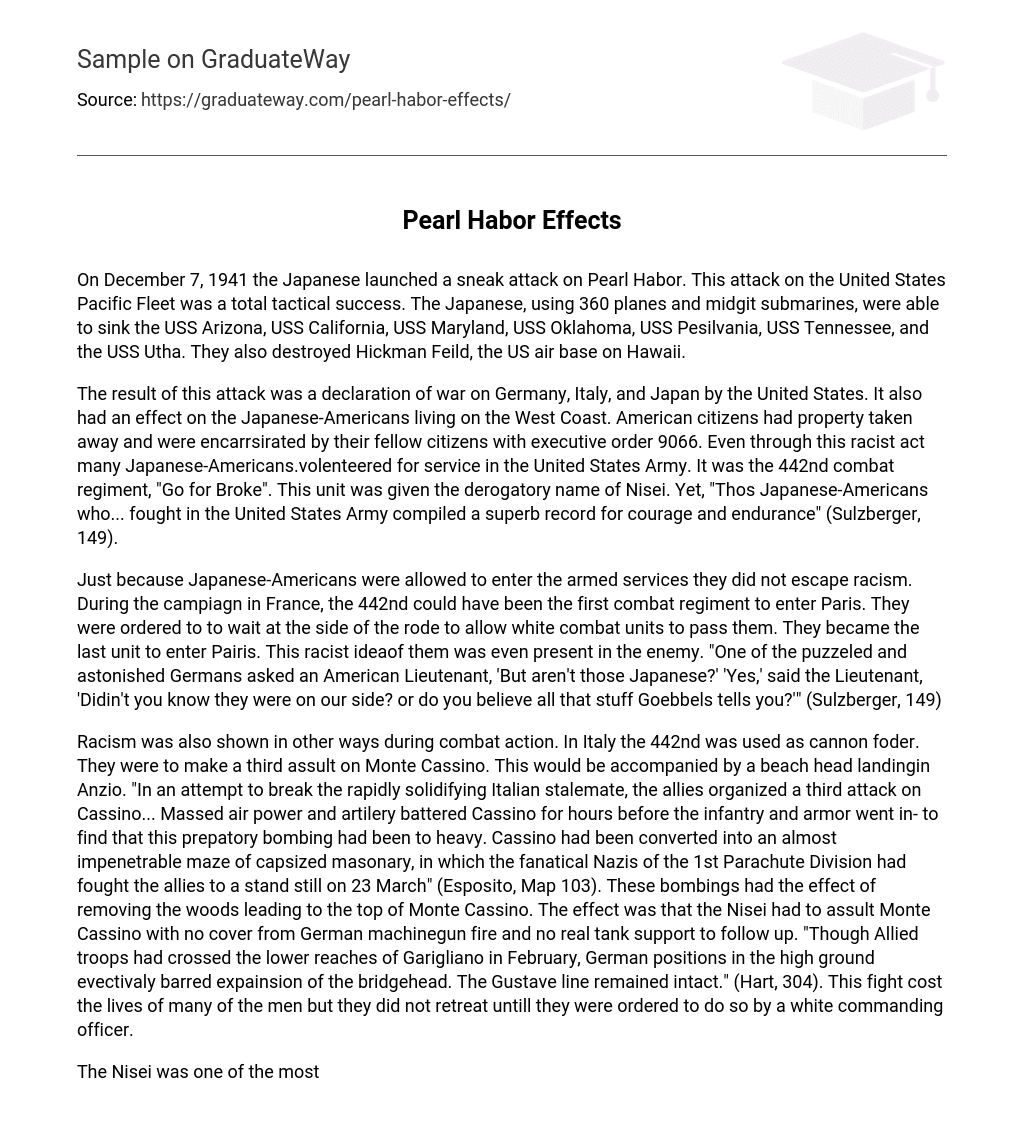On December 7, 1941 the Japanese launched a sneak attack on Pearl Habor. This attack on the United States Pacific Fleet was a total tactical success. The Japanese, using 360 planes and midgit submarines, were able to sink the USS Arizona, USS California, USS Maryland, USS Oklahoma, USS Pesilvania, USS Tennessee, and the USS Utha. They also destroyed Hickman Feild, the US air base on Hawaii.
The result of this attack was a declaration of war on Germany, Italy, and Japan by the United States. It also had an effect on the Japanese-Americans living on the West Coast. American citizens had property taken away and were encarrsirated by their fellow citizens with executive order 9066. Even through this racist act many Japanese-Americans.volenteered for service in the United States Army. It was the 442nd combat regiment, “Go for Broke”. This unit was given the derogatory name of Nisei. Yet, “Thos Japanese-Americans who… fought in the United States Army compiled a superb record for courage and endurance” (Sulzberger, 149).
Just because Japanese-Americans were allowed to enter the armed services they did not escape racism. During the campiagn in France, the 442nd could have been the first combat regiment to enter Paris. They were ordered to to wait at the side of the rode to allow white combat units to pass them. They became the last unit to enter Pairis. This racist ideaof them was even present in the enemy. “One of the puzzeled and astonished Germans asked an American Lieutenant, ‘But aren’t those Japanese?’ ‘Yes,’ said the Lieutenant, ‘Didin’t you know they were on our side? or do you believe all that stuff Goebbels tells you?'” (Sulzberger, 149)
Racism was also shown in other ways during combat action. In Italy the 442nd was used as cannon foder. They were to make a third assult on Monte Cassino. This would be accompanied by a beach head landingin Anzio. “In an attempt to break the rapidly solidifying Italian stalemate, the allies organized a third attack on Cassino… Massed air power and artilery battered Cassino for hours before the infantry and armor went in- to find that this prepatory bombing had been to heavy. Cassino had been converted into an almost impenetrable maze of capsized masonary, in which the fanatical Nazis of the 1st Parachute Division had fought the allies to a stand still on 23 March” (Esposito, Map 103). These bombings had the effect of removing the woods leading to the top of Monte Cassino. The effect was that the Nisei had to assult Monte Cassino with no cover from German machinegun fire and no real tank support to follow up. “Though Allied troops had crossed the lower reaches of Garigliano in February, German positions in the high ground evectivaly barred expainsion of the bridgehead. The Gustave line remained intact.” (Hart, 304). This fight cost the lives of many of the men but they did not retreat untill they were ordered to do so by a white commanding officer.
The Nisei was one of the most highly decorated fighting units in World War II. Unfortunatlly, they did not recieve these decorations until well after the end of the war. These Japanese-Americans took the derogatory term Nisei, washed it in a river of blood, and made it a name that Japanese-Americans can use with pride.





